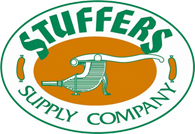Ingredients for Sausage & Processed Meats
Use of Ingredients for Sausage & Processed Meats
Water
- Use of ice in formulation can help to lower product temperatures during processing.
- Mixing/tumbling near 0 degrees C. will increase protein extraction and water binding ability and minimize fat smear.
- Use of ice in formulation can help to lower product temperatures during processing.
- Mixing/tumbling near 0 degrees C. will increase protein extraction and water binding ability and minimize fat smear.
Meat
- Main source of moisture, protein and fat.
- Adhering pork or poulty skin (in natural proportions, up to 8%) can form part of the meat block.- Minimum meat protein or maximum fat levels in products may be regulated. (See Schedule 1 of the Meat Inspection Act.)
- Main source of moisture, protein and fat.
- Adhering pork or poulty skin (in natural proportions, up to 8%) can form part of the meat block.- Minimum meat protein or maximum fat levels in products may be regulated. (See Schedule 1 of the Meat Inspection Act.)
Mechanically Separated Meats
- Susceptible to oxidation and spoilage so use promptly.
- Creates soft texture at high level of usage.
- Fresh sausage, burgers and steakettes, meat loaf (and others) with mechanically separated meats must be sold frozen.
- Meat byproducts are made of whole blood or blood plasma (generally beef) BYPRODUCTS tripe*, swine stomach, liver.
- *Beef tripe and other byproducts must be specially prepared before they are considered edible. (See agric. Canada Manual of Procedures.)
- Protein from meat byproducts is less functional in terms of bind/water holding.
Salt
- Sodium chloride - For flavoring, solubilizes muscle proteins, retards microbial growth and may redurce water activity.
- Use a good grade of salt to reduce levels of trace impurities.
- Protein extraction is enhanced with salt levels above 1%.
- Potassium chloride - Similar to salt
- Potassium chloride can impart metallic flavors if used at greater than 0.75%.
Curing Agents
- Sodium nitrite or potassium nitrite.
- Source of nitric oxide for curing.
- Imparts cured meat color and flavor, decreases oxidation and prevents outgrowth.
- Sodium nitrite is commonly added as a cure salt such as Prague powder.
- Cured units have a limited shelf-life, check the "use by" date.
- Cures that have black specks or are yellow in color are unstable and should be discarded.
- Nitrate is converted to nitrite by bacteria.
- Nitrates are only permitted in specialty products which require a long cure time eg. dried sausage, proscuitto.
Cure Accelerators
- Sodium ascorbate or Sodium erythorbate accelerates the curing process and protects color in cured meats.
- Delays discoloration of fresh sausage.
- Don't mix curing agents and cure accelerators together dry.
- Optimize addition to keep formulation costs down.
- Fresh sausage must be labelled as "fresh preserved sausage" if ascorbate or erythorbate are used.
- Ascorbic acid accelerates the curing process and protects color in Erythorbic acid cured meats. Delays discoloration of fresh sausage.
- Acid forms react more quickly, but may cause emulsions to short out if used at higher levels. Acidifiers will also speed up the cure process.
PH Adjusting Agents (Acidifiers)
- Susceptible to oxidation and spoilage so use promptly.
- Creates soft texture at high level of usage.
- Fresh sausage, burgers and steakettes, meat loaf (and others) with mechanically separated meats must be sold frozen.
- Meat byproducts are made of whole blood or blood plasma (generally beef) BYPRODUCTS tripe*, swine stomach, liver.
- *Beef tripe and other byproducts must be specially prepared before they are considered edible. (See agric. Canada Manual of Procedures.)
- Protein from meat byproducts is less functional in terms of bind/water holding.
Salt
- Sodium chloride - For flavoring, solubilizes muscle proteins, retards microbial growth and may redurce water activity.
- Use a good grade of salt to reduce levels of trace impurities.
- Protein extraction is enhanced with salt levels above 1%.
- Potassium chloride - Similar to salt
- Potassium chloride can impart metallic flavors if used at greater than 0.75%.
Curing Agents
- Sodium nitrite or potassium nitrite.
- Source of nitric oxide for curing.
- Imparts cured meat color and flavor, decreases oxidation and prevents outgrowth.
- Sodium nitrite is commonly added as a cure salt such as Prague powder.
- Cured units have a limited shelf-life, check the "use by" date.
- Cures that have black specks or are yellow in color are unstable and should be discarded.
- Nitrate is converted to nitrite by bacteria.
- Nitrates are only permitted in specialty products which require a long cure time eg. dried sausage, proscuitto.
Cure Accelerators
- Sodium ascorbate or Sodium erythorbate accelerates the curing process and protects color in cured meats.
- Delays discoloration of fresh sausage.
- Don't mix curing agents and cure accelerators together dry.
- Optimize addition to keep formulation costs down.
- Fresh sausage must be labelled as "fresh preserved sausage" if ascorbate or erythorbate are used.
- Ascorbic acid accelerates the curing process and protects color in Erythorbic acid cured meats. Delays discoloration of fresh sausage.
- Acid forms react more quickly, but may cause emulsions to short out if used at higher levels. Acidifiers will also speed up the cure process.
PH Adjusting Agents (Acidifiers)
- Glucono delta lactone (GDL) - Intended to decrease pH (releases gluconic acid in (ACIDIFIERS) presence of water).
- Used in sausage and fermented sausage.
- Products with GDL or citric acid should be stuffed and cooked immediately to avoid emulsion breakdown.
- Citric acid - Used in pumping pickle, sausages.
- Sodium citrate - GDL and citric acid contribute to acidic flavor.
Alkaline Phosphates
Sodium phosphates: Sodium tripoly phosphate, Sodium hexameta phosphate.
- Generally increases pH, ionic strength and water holding, retards oxidation. Improves yields, increases emulsion stability.
- Phosphates can impart metallic flavors if used at levels greater than 0.45%.
- Recent changes to regulations have expanded permitted uses but require that products meet minimum meat protein levels of 10% raw or 12% cooked for nonstandardized products and existing protein regulations for products specified in the Meat Inspection Act.
- If phosphate won't dissolve in brine, increase mixing actiion or change order of addition ie add first to brine before salt.
Acid Phosphates
- Sodium acid pyrophosphate
- Decreases pH to speed cure dev.
- Not typically used in sausage as rapid pH decline could cause emulsion breakdown.
Sweeteners
Sugar (sucrose) Brown Sugar
- Flavoring, lower water activity, provide browning.
- Sucrose is the sweetest, dextrose intermediate and Dextrose glucose solids or corn syrup solids are the least sweet.
- Sweeteners moderate saltiness.
- Use dextrose for increased browning.
- Glucose solids - When the meat industry refers to "glucose", they usually mean "glucose solids", a hydrolyzed starch product.
- Corn syrup solids - Corn syrup solids are used in similar applications to glucose solids.
- Lactose (milk sugar) is a major component of skim milk powder (50% lactose) and is slightly sweet. Not usually added alone.
Gelling Agents
- Gelatin or Carrageenan.
- Gelatin strength is indicated by "Bloom" #
- Carrageenan or gelatin cannot be injected but can be tumbled/massaged into cured ham and poultry items.
Binders / Fillers ( or extenders )
- Toasted wheat crumbs or cracker crumbs, starches and flours (natural or modified), soy protein flours, concentrates and isolates (powdered or textured), caseinates, whey, skim milk powder, buttermilk powder, hydrolyzed milk protein.
- To minimize fry-away, source of nonmeat protein, absorb moisture, water and fat binding, texture modification, color and flavor.
- Enzymatic activity in wheat flour destroys color so use sparingly in fresh sausage.
- Starches and flours must be heated sufficiently for mazimum functionality.
- Textured veg. proteins (TVP) are useful in burgers, steakettes, pizza toppings.
- Milk ingredients provide creamy flavor and texture to liver sausage and may help to "whiten" color of chicken products.
Bacterial Culture
- Used for flavor, acidification (lactic acid produced during fermentation).
- Available in frozen or freeze dried forms.
- Dextrose is often used as nutrient source.
- Careful control of temperature and dextrose level are needed to produce safe fermented products with sufficient acidity.
- Add culture last during mixing.
Smoke
- You can use naturally smoked, smoke, liquid smoke (Recondensed from burning wood), or artificial smoke.
- Used for flavoring, coloring or antimicrobial.
- smoked product color and flavor dev. influenced by surface dryness, oven temp. & relative humidity, air velocity, type of wood, smoke generator temp.
- A dry color setting step is necessary when using atomized liquid smoke.
- Smoke products used for direct addition are specially formulated. May be liquid or powdered.
Flavorings, Spices and Seasonings
- If garlic or onion contribute a distinct flavor, then SPICES Dried herbs should be listed separately.
- Use natural dried spices for an "old world" look.
- Used for flavor and appearance.
- Deheated mustard - Intended to flavor, for water holding, control purge, source of nonmeat protein.
- Yeast - Yeast ingredients cannot contribute more than 1% protein to product. Flavor enhancing effect due to glutamate content.
Coloring Agents
- Carmel coloring is typically used as a coating for roast beef or Black Forest AGENTS ham. Injection not allowed.
- Annatto provides distinct yellow coloring ot Longaniza and Tocino.
- Generally coloring agents are not permitted in meat products due to potenitial masking of spoilage.
Flavor Enhancers
-Hydrolyzed plant or vegetable protein (HPP, HVP) contain glutamates so cannot use "No MSG added" on label.
- Monosodium glutamate (MSG) which some individuals may be sensitive to.
- Disodium guanylate or Disodium Inosinate act synergistically with MSG to boost flavor.
Ground Meats
- Regular can be maximum 30% fat.
- Medium can be maximum 23% fat.
- Lean can be maximum 17% fat.
Meat Patties
- To be called patties, only seasoning can be added (ie. no fillers or binders, no extra water).
Meat Burgers, ECT
- Can be burgers, meat balls, chopettes, steakettes, cutlets, etc.
- Binders / fillers and extra water are allowed.
- If mechanically separated meats are used, must be sold frozen (in the raw state).
Fresh Sausage (READY TO EAT)
- Can be breakfast saus., dinner saus. or sausage meat.
- If product contains ascorbate / erythorbate, must be called "preserved" sausage.
- Can be salami, pepperoni, wieners, bologna, liver sausage, blood pudding, etc.
- To be cured, and either smoked, cooked, dried and fermented.
- May contain water, salt, cure, phosphate, binders / fillers, seasoning, sweeteners, etc.
- Fermented sausage may also contain lactic avcid starter cultures and GDL.
Meat Loaf, ect.
- Is meat loaf, or luncheon meats and can be cooked, and either cured or frozen.
- Ingredients allowed are similar to sausage.
- A gelling agent may also be used.
General Comments:
Other meat products for which standards exist include: liver pate, corned beef, meat pies, wieners with beans, headcheese, stew, etc. See Schedule 1 of the Meat Inspection Act for more details.
Re Phosphate addition: Recent changes to regulations have expanded permitted uses for phosphates, but require that nonstardized meat products must meet minimum meat protein levels of 0.0% raw or 12.0% cooked and standardized products must meet existing protein regulations as specified above. Use of phosphates in undstandardized products (such as hams, roast beef, marinated items, etc.) may affect labeling and may require core nutrition information on package.
- Can be burgers, meat balls, chopettes, steakettes, cutlets, etc.
- Binders / fillers and extra water are allowed.
- If mechanically separated meats are used, must be sold frozen (in the raw state).
Fresh Sausage (READY TO EAT)
- Can be breakfast saus., dinner saus. or sausage meat.
- If product contains ascorbate / erythorbate, must be called "preserved" sausage.
- Can be salami, pepperoni, wieners, bologna, liver sausage, blood pudding, etc.
- To be cured, and either smoked, cooked, dried and fermented.
- May contain water, salt, cure, phosphate, binders / fillers, seasoning, sweeteners, etc.
- Fermented sausage may also contain lactic avcid starter cultures and GDL.
Meat Loaf, ect.
- Is meat loaf, or luncheon meats and can be cooked, and either cured or frozen.
- Ingredients allowed are similar to sausage.
- A gelling agent may also be used.
General Comments:
Other meat products for which standards exist include: liver pate, corned beef, meat pies, wieners with beans, headcheese, stew, etc. See Schedule 1 of the Meat Inspection Act for more details.
Re Phosphate addition: Recent changes to regulations have expanded permitted uses for phosphates, but require that nonstardized meat products must meet minimum meat protein levels of 0.0% raw or 12.0% cooked and standardized products must meet existing protein regulations as specified above. Use of phosphates in undstandardized products (such as hams, roast beef, marinated items, etc.) may affect labeling and may require core nutrition information on package.





















